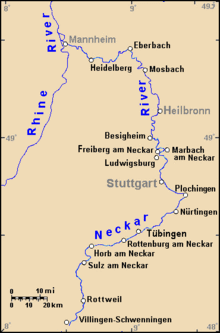
Back Neckar Afrikaans Neckar ALS نيكار Arabic نهر نيكار ARZ Nekkar çayı Azerbaijani نکار چایی AZB Некар Byelorussian Нэкар BE-X-OLD Некар Bulgarian Neckar Breton
This article needs additional citations for verification. (December 2019) |
| Neckar | |
|---|---|
 The Neckar near Stuttgart | |
 | |
| Location | |
| Country | Germany |
| Physical characteristics | |
| Source | |
| • location | Black Forest |
| • elevation | 706 m (2,316 ft) |
| Mouth | |
• location | Rhine |
• coordinates | 49°30′43″N 8°26′14″E / 49.51194°N 8.43722°E |
| Length | 362.4 km (225.2 mi)[1] |
| Basin size | 13,928 km2 (5,378 sq mi)[1] |
| Discharge | |
| • average | 145 m3/s (5,100 cu ft/s) |
| Basin features | |
| Progression | Rhine→ North Sea |
 | |
The Neckar (German pronunciation: [ˈnɛkaʁ] ⓘ) is a 362-kilometre-long (225 mi) river in Germany, mainly flowing through the southwestern state of Baden-Württemberg, with a short section through Hesse. The Neckar is a major right tributary of the Rhine. Rising in the Schwarzwald-Baar-Kreis near Schwenningen in the Schwenninger Moos conservation area at a height of 706 m (2,316 ft) above sea level, it passes through Rottweil, Rottenburg am Neckar, Kilchberg, Tübingen, Wernau, Nürtingen, Plochingen, Esslingen, Stuttgart, Ludwigsburg, Marbach, Heilbronn and Heidelberg, before discharging on average 145 m3/s (5,100 cu ft/s) of water into the Rhine at Mannheim, at 95 m (312 ft) above sea level, making the Neckar its 4th largest tributary, and the 10th largest river in Germany. Since 1968, the Neckar has been navigable for cargo ships via 27 locks for about 200 kilometres (120 mi) upstream from Mannheim to the river port of Plochingen, at the confluence with the Fils.
From Plochingen to Stuttgart, the Neckar valley is densely populated and heavily industrialised, with several well-known companies. Between Stuttgart and Lauffen, the Neckar cuts a scenic, meandering, and in many places steep-sided, valley into fossiliferous Triassic limestones and Pleistocene travertine. Along the Neckar's valley in the Odenwald hills many castles can be found, including Hornberg Castle and Guttenberg Castle in Haßmersheim; the now-mothballed Obrigheim Nuclear Power Plant and the active Neckarwestheim Nuclear Power Plant are also located there.




Traditionally the fertile plains have been intensively used for agriculture and its steep valley sides as vineyards.